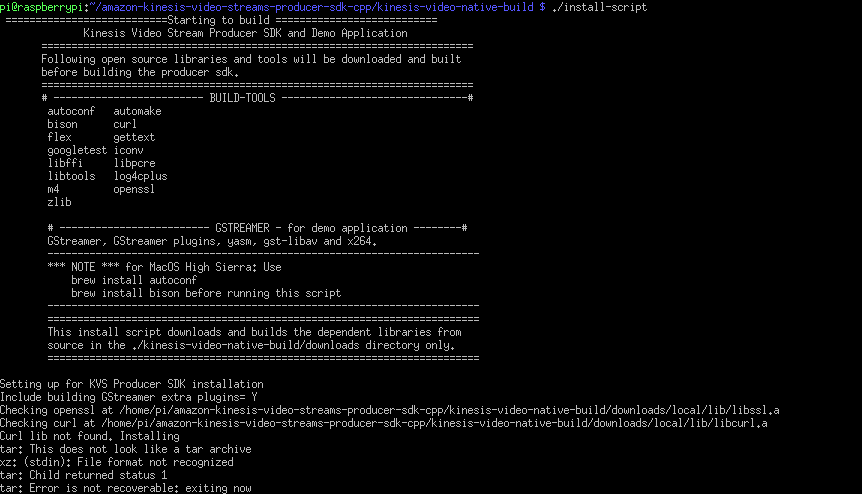

- Install gstreamer raspberry pi install#
- Install gstreamer raspberry pi update#
- Install gstreamer raspberry pi code#
- Install gstreamer raspberry pi free#
Now run an update (which will make use of the line just added): You need to edit the sources.list file so enter:Īnd add the following to the end of the file: So, gstreamer can provide an excellent low latency video link, which is great if you are techy enough to set it up at both ends, but its no good if you want to directly stream so that Joe public can see the video on a web site for instance.įor more information visit :- Gstreamer Setting Up The Raspberry Pi To Use gstreamer
Install gstreamer raspberry pi install#
gstreamer is a development framework not a media player and there isn't a way to stream so that common players such as VLC can display the stream (without users having to install complex plugins).

The catch is that you need need gstreamer on the client used to view the stream. Gstreamer allows you to stream video with very low latency – a problem with VLC currently. With a CSI camera, both capturing and encoding were handled by the GPU.Live Web Streaming on the Raspberry Pi using gstreamer What is Gstreamer Also, note that the RPi CPU is used more (17%) in this case because the frames are captured by the CPU and only the encoding is handled by the GPU. But I must mention that a part of this latency is due to my camera which provides only 10 FPS at HD resolution. Repeating the same stopwatch test shows that the USB camera has more latency (around 800ms).
Install gstreamer raspberry pi code#
configure -arch=armel -target-os=linux -enable-gpl -enable-omx -enable-omx-rpi –enable-nonfreeģ – Back in the laptop, build and run th is code (replace the IP with your laptop’s IP): #include As I said, I don’t recommend them with RPi but in case you don’t have access to a CSI camera or want to save your budget by using an old webcam, then this section is for you.ġ- Make sure your laptop’s OpenCV support FFMpeg.Ģ – In the R pi, build FFmpeg with h264 GPU encoding flags: git clone USB cameras are more available than CSI’s. You can also increase bitrate to get a higher quality stream if your Laptop’s CPU is powerful enough to render the frames. Note that RPi CPU usage is below 5% and you can use it for other tasks. This means 200ms latency which is good for 1920×1080 resolution.

To check the latency, I put the camera in front of a stopwatch and then captured an image by my cellphone.

VideoCapture cap("udpsrc port=5000 ! gdpdepay ! rtph264depay ! avdec_h264 ! videoconvert ! appsink sync=false") ĥ- And last, i n the Rpi run this command (replace host IP with your laptop’s IP) : gst-launch-1.0 rpicamsrc bitrate=6000000 ! 'video/x-h264,width=1920,height=1080' ! h264parse ! queue ! rtph264pay config-interval=1 pt=96 ! gdppay ! udpsink host=10.42.0.1 port=5000 autogen.sh -prefix=/usr -libdir=/usr/lib/arm-linux-gnueabihf/Ĥ- Back in the laptop, build and run th is code: #include Make sure your new OpenCV recognizes gstreamer:ģ- In the R Pi, install gst-rpicamsrc sudo apt-get install autoconf automake libtool pkg-config libgstreamer1.0-dev gstreamer1.0-tools Supposing that you want to stream from an RPi to an Ubuntu Laptop:ġ- I nstal l GStreamer in the laptop using: sudo apt -y install libgstreamer1.0-dev libgstreamer-plugins-base1.0-devĢ- In the laptop, r e-compile your OpenCV with -DWITH_GSTREAMER=ON flag in CMake. They have a wide variety of board cameras with different sensors and lenses. You may find the official CSI cameras unsuitable for your project.
Install gstreamer raspberry pi free#
This means that the CPU remains free for other operations. I generally recommend to use CSI cameras with Raspberry Pi because they are directly captured by the GPU. You can later add text, layers, or do any other process you wish. The stream is then received frame-by-frame in an OpenCV code. They key to achieve this is to do the h264 encoding on the RPi GPU (not CPU). But when it comes to real-time video streaming, you may find yourself lost in a bunch of long-reptile shell commands! In this post, I will give you some crystal clear instructions to receive a low-latency stream from a CSI or USB camera. Raspberry Pi boards are getting more and more widespread.


 0 kommentar(er)
0 kommentar(er)
